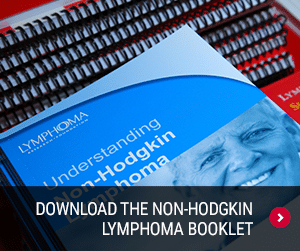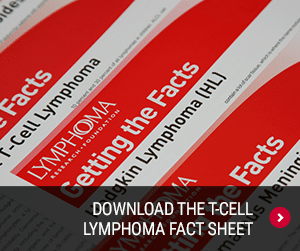
What is Lymphoma?
T-Cell Lymphoma
T-cell lymphomas are a form of non-Hodgkin lymphoma (NHL) that can develop in lymphoid tissues such as the lymph nodes and spleen, or outside of lymphoid tissues (i.e., gastrointestinal tract, liver, nasal cavity, skin, and others). T-cell lymphomas account for about seven percent of all NHLs in the United States according to the Surveillance, Epidemiology, and End Results program. Each particular subtype of T-cell lymphoma is very uncommon. They can be aggressive (fast-growing) or indolent (slow-growing).
A similar lymphocyte called a natural killer (NK) cell shares many features with T cells. When NK cells become cancerous, the cancer is called NK or NK/T-cell lymphoma and is generally grouped with other T-cell lymphomas.
Common Types of T-Cell Lymphoma
Lymphomas are often, but not always, named from a description of the normal cell that leads to cancer. Lymphomas that arise from mature T cells are sometimes categorized together under the general term peripheral T-cell lymphoma (PTCL), which distinguishes them from the lymphoma that arise from immature T cells or lymphoblastic lymphoma. Under this broad meaning, almost all types of T-cell lymphoma fall under the category of PTCL.
Peripheral T-Cell Lymphoma, Not Otherwise Specified
Peripheral T-Cell Lymphoma, Not Otherwise Specified (PTCL-NOS) refers to a group of diseases that do not fit into any of the other PTCL subtypes. PTCL-NOS accounts for about 20 percent of T-cell lymphomas and is the most common PTCL subtype. Although most patients with PTCL-NOS are diagnosed with their disease confined to the lymph nodes, sites outside the lymph nodes, such as the liver, bone marrow, gastrointestinal tract, and skin, may also be involved. Patients with this subtype of PTCL will frequently have constitutional symptoms (i.e., fevers, serious night sweats, and unexplained weight loss).
Anaplastic Large Cell Lymphoma
Anaplastic Large Cell Lymphoma (ALCL) describes several types of T-cell lymphomas and accounts for approximately one percent of all NHLs and 11 percent of all T-cell lymphomas. Initial symptoms of ALCL can include fever, backache, painless swelling of lymph nodes, loss of appetite, itching, skin rash, and tiredness.
ALCL can be either systemic (occurring throughout the body) or cutaneous (limited to the skin). Systemic ALCL is typically in an advanced stage at diagnosis and can progress rapidly. The systemic subtype is further classified as ALK-positive or ALK-negative, depending on whether or not it contains an abnormal anaplastic lymphoma kinase (ALK) fusion protein that results from a genetic event. Systemic ALCL, especially ALK-positive disease, can respond well to treatment and is potentially curable. ALK-negative patients may require more aggressive treatments, and relapse (disease returns after treatment) occurs more frequently than in ALK-positive disease. The non-systemic type is called primary cutaneous anaplastic large cell lymphoma, appears only on the skin, and has a good prognosis. For more information, download the Anaplastic Large Cell Lymphoma Fact Sheet.
Angioimmunoblastic T-Cell Lymphoma
Angioimmunoblastic T-Cell Lymphoma (AITL) is a rare, aggressive type accounting for about seven percent of all patients with T-cell lymphomas in the United States. Most patients are middle-aged to elderly and are diagnosed with advanced-stage disease. There is some evidence that AITL develops from an ongoing immune response potentially due to latent viral infection (like Epstein-Barr virus). Initial symptoms often include fever, night sweats, skin rash, itching, and some autoimmune disorders such as autoimmune hemolytic anemia (AIHA; where the immune system attacks red blood cells) and immune thrombocytopenia (ITP; where the immune system attacks platelets).
For more information, download the Angioimmunoblastic T-cell Lymphoma Fact Sheet.
Cutaneous T-Cell Lymphoma
Cutaneous T-Cell Lymphoma (CTCL) accounts for two to three percent of all NHL cases and usually affects adults. The term cutaneous T-cell lymphoma describes a group of typically indolent lymphomas that appear on, and are most often confined to, the skin.
Mycosis fungoides, which appears as skin patches, plaques, or tumors, is the most common type of CTCL. Patches are usually flat, possibly scaly, and look like a rash; plaques are thicker, raised, usually itchy lesions that are often mistaken for eczema, psoriasis, or dermatitis; and tumors are raised bumps, which may or may not ulcerate. More than one type of lesion may be present at any time.
Sézary syndrome is a less common form of CTCL that affects both the skin and blood. Most cases occur in adults over the age of 60 years. The most common symptoms are swollen lymph nodes and a red, very itchy rash that covers large portions of the body. Abnormal T cells, called Sézary cells, can be seen under a microscope and are present in both the skin and blood.
Other, rare forms of CTCL include primary cutaneous anaplastic large cell lymphoma and lymphomatoid papulosis. For more information, download the Cutaneous T-Cell Lymphoma Fact Sheet.
Uncommon Types of T-Cell Lymphoma
Adult T-Cell Leukemia/Lymphoma and Lymphoblastic Lymphoma are also types of T-Cell Lymphoma, though diagnoses are rare.
Adult T-Cell Leukemia/Lymphoma
Adult T-Cell Leukemia/Lymphoma (ATLL) is a rare and often aggressive form of T-cell lymphoma that can be found in the blood (leukemia), lymph nodes (lymphoma), skin, or multiple areas of the body. ATLL has been linked to infection by the human T-cell lymphotropic virus type 1 (HTLV-1).
This virus is commonly found in people from the Caribbean, parts of Japan, and some areas of South and Central America and Africa, as well as sporadic cases from around the world. People usually acquire the virus at birth or during breastfeeding. Less than five percent of those who carry the virus will develop lymphoma. This lymphoma requires urgent treatment in most patients and stem cell transplantation is frequently needed for cure.
For more information, download the Adult T-Cell Leukemia/Lymphoma Fact Sheet.
Lymphoblastic Lymphoma
Lymphoblastic Lymphoma can arise from either immature B cells or T cells, but more commonly comes from T cells, comprising more than 80 percent of all lymphoblastic lymphomas.
This type of lymphoma is most often diagnosed in adolescents and young adults and is a bit more common in men than women. Tumors frequently arise in the middle of the chest, or mediastinum, though lymphoma cells may appear in the lymph nodes as well as in the bone marrow or spleen. Central nervous system involvement is more common than in other T-cell lymphomas.
This lymphoma, like other subtypes, can result in impaired immunity and opportunistic infections, and interfere with the body’s ability to make blood cells resulting in fatigue and bleeding. This lymphoma is aggressive and can progress rapidly, if not properly treated. With intensive chemotherapy, the complete remission rate can be very high and many patients can be cured.
To learn more about T-cell lymphoma, download the T-Cell Lymphoma Fact Sheet.


